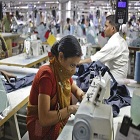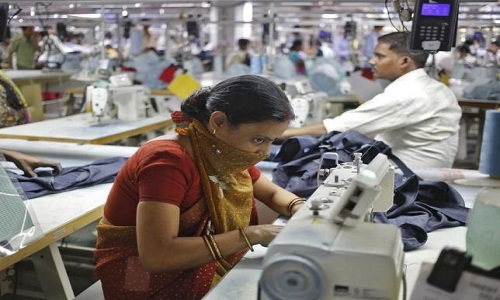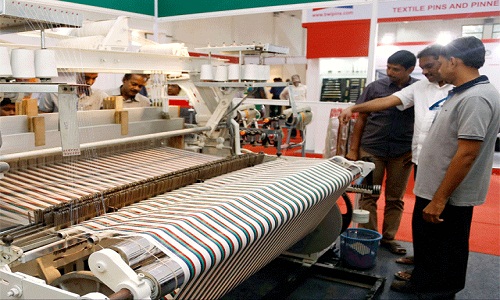FW
"With the amendment of labour laws, women workforce will be able to work during night shift. As per existing norms, women are allowed to work only in the day. With the textiles sector being the second-largest employment provider with over 50 per cent coming in from women segment in rural India, it is important to facilitate women workforce adequate policy support to work during the night shift."

India’s new National Textile Policy is close to finalisation and expected by end of April, 2016 during the Budget session. The new policy is expected to accommodate a series of reforms to make India a truly manufacturing hub for textiles. The idea is for Indian textiles players to take maximum advantage of China’s slowdown in textiles sector.
Labour law amendments

With the amendment of labour laws, women workforce will be able to work during night shift. As per existing norms, women are allowed to work only in the day. With the textiles sector being the second-largest employment provider with over 50 per cent coming in from women segment in rural India, it is important to facilitate women workforce adequate policy support to work during the night shift. The government has also laid specific focus on reducing transportation cost, as a result of which the cotton seed transport cost has come down by almost 25 to 40 per cent.
Initiatives galore
According to Santosh Kumar Gangwar, Minister of State for textiles, the ministry has given approval to 24 new textile parks which will create employment for an additional 4,50,000 people. In addition, the textile ministry has also written to the ministry of finance to lower interest rates to 7 per cent on working capital to which works out to 10.5 per cent. A sudden spurt in interest rates from 3.5 per cent to 10.5 per cent has resulted into many manufacturing units closing down and others facing huge squeeze in their profit margins.

The government is looking into special incentives for manufacturing units being set up in the Northeastern states including Bihar, Jharkhand and West Bengal where cost of production would work out to lower than existing places like Maharashtra and Gujarat. Labour is cheap there. So, the pressure of high cost of production would certainly ease to certain extent, according to industry analysts. The government has focused on skilling of youth in various sectors. Through this, around 625,000 of skilled manpower have been given employment in textiles sector in the last 18 months.
Reaping from Chinese slowdown
According to Gangwar, the slowdown in Chinese economy has rendered cost of textile production in China high. So, Chinese textiles manufacturers have lost their competitive advantage in the last few months. This has offered an opportunity for Indian players to grab market share in the developed world especially the European Union and United States, which cumulatively consists of around 60 per cent of the global export market. This is the right time to increase our market share in exports, he opined.
Moreover, to cope with regional trade block agreements such as Trans Pacific Partnership (TPP) the government is working towards Foreign Trade agreement (FTA) with European Union and holding comprehensive discussions on the Regional Comprehensive Economic Partnership (RCEP). The government is in the process of reviewing existing trade agreements such as Indo-ASEAN FTA and Indo-Korea Comprehensive Economic Partnership Agreement (CEPA).
Apart from that the government would also facilitate exports schemes to promote textiles exports. In India, textile manufacturers are currently enjoying various exports incentives schemes including MEIS and duty drawbacks. The minster is confident that the, inclusive and participatory vision of the government would give long term benefits.
A global leader in color and specialty chemicals, Archroma and DKTE Society’s Textile & Engineering Institute, Ichalkaranji for Technical Textiles (DKTE), based in Kolhapur, India, have entered into a fice-year partnership aiming at sharing Archroma’s globally recognised expertise in the area of Technical Textiles and Nonwovens with the Institute’s faculty and students.
Under the partnership, Archroma will provide training sessions, as well as technical support and guidance to the students of the Institute. In particular, DKTE’s students will have access to some of Archroma’s technical laboratories in India and Switzerland for projects, experiments and trials.
Through the new arrangement, the students will also benefit from access to a range of functional products with application and performance characteristics critical to the industry, allowing them to gain hands-on training and learning, and help develop innovative solutions for new industry entrants. The DKTE’s faculty has already expressed special interest in Archroma’s Nuva® N water and oil repellent solutions, Pekoflam® non-halogenated flame retardant, Sanitized® antimicrobials, Appretan® solutions for textile strength and flexibility, or Hydroperm® hydrophilisizing agent.
Sustainable innovations have come to the fore in textile industry. A new technology that converts waste cotton into a raw material that can then be used to produce new textiles has been developed. This has won s won the largest slice of a $1.1 million grant backed by Swedish fashion giant H&M. The first Global Change Award from non-profit H&M Conscious Foundation is aimed at encouraging pioneering ideas on closing the loop in fashion.
Other projects that won include a polyester digester that uses microbes to recycle waste polyester textiles; an online marketplace for textile leftovers; an initiative to create new textiles out of by-products from citrus juice production; and a scheme that uses algae to grow textile fibers under water.
One technology uses an environmentally-friendly solvent to dissolve the cotton in textile waste – which can then be spun into new cotton-like fibers. This not only reduces landfill waste but also saves natural resources.
A new type of microbe breaks down waste polyester into its most basic substances, which can then be sold to polyester manufacturers to produce new textiles. Polyester is the world’s most common fiber for making textiles and clothes but is difficult to recycle since it is often mixed with other fibers. The new microbe process would work on textiles where polyester and cotton are mixed as well as dyed polyester.
Growing textile fiber under water also involves researching a new textile raw material derived from marine algae. One of its strengths would be to eliminate the need to transport textiles as production could be based at coastal regions around the globe. Winners of the Global Change Award will also get help to develop their ideas over the next year from H&M Conscious Foundation, Accenture and KTH Royal Institute of Technology in Stockholm, Sweden
Despite the increasing demand from textile and apparel industries, production of organic cotton is on the decline and poses a tremendous risk to both the environment and the future of sustainably-produced fabrics. The aim of the Organic Cotton Accelerator (OCA) - a multi-stakeholder initiative spearheaded in 2013 by US retailer Eileen Fisher and European brands C&A, H&M and Kering is to identify and fund interventions, strategies and new areas of development and opportunity to increase organic cotton production.
According to Shona Quinn, sustainability leader for Eileen Fisher, organic cotton production and innovation in the industry is critical to the future of sustainable apparel, namely her brand’s commitment to consumers who are already seeking lifestyle changes that often begin and end with their clothing purchases. OCA plans to set the standard for organic farmer training by establishing a central farmer curriculum, knowledge transfer, and best known agricultural and business practices to improve effectiveness. In addition to providing training curriculum, the OCA will create a distribution system to reach farmers with 100 per cent organic seeds to protect the integrity of cotton crops.
Meanwhile, the OCA’s established financing model will be made available to farmers in the form of revolving loans. The approximate numbers of available financing dollars and farmer repayment terms have yet to be revealed. OCA is set to launch this year in a two-year prototyping phase where selected farmers across India will participate during the incubation period — with the goal of increasing strategies to scale organic cotton production through 2018.
Apparel sector associates in Sri Lanka are to be supported by the country’s largest private bank with an exclusive debit card that confers special benefits, under a partnership between the Commercial Bank of Ceylon, the Joint Apparel Association Forum (JAAF) and Channel 17, the company tasked with managing an employee loyalty program for the sector.
Holder of the card will be eligible to receive extensive collection of discounts and offers normally enjoyed by Commercial Bank Debit Card holders. In addition to the benefits they are entitled to under the Ransalu program. The card will also serve as identification for them to claim benefits from the Ransalu loyalty program, which targets a membership of over 350,000.
Meanwhile, the Ransalu Privilege Loyalty Program already offers members discounts on essential consumer items, hospitalisation, pharmaceutical products and clothing. However, the JAAF membership targeted Commercial Bank – MasterCard issued ‘Ransalu Privilege Card’ will be available free of charge to any member of the JAAF operated Ransalu Loyalty Program who has, or opens an account with Commercial Bank.
Jute mills fear a financial crunch in the wake of the jute commissioner’s decision to fix the price of bags for January and February. They fear an estimated loss of Rs 70 crores in the two months following enforcement of the price cap (at around Rs 79,000 per ton).
The decision to fix price followed the spiraling rates of the raw fiber owing to excess rainfall, shrinking area under cultivation and an export ban imposed by Bangladesh. Average raw jute prices have increased to Rs 5,357 per quintal in January from Rs 4,034 per quintal in August.
This decision to fix prices has led to a situation where many mills are unable to manage their minimum working capital requirements, including wage payments and clearance of statutory dues. The stock limit of raw jute for traders has been lowered to 500 quintals from 1,700 quintals.
Meanwhile the new national textile policy may be unveiled by April. The policy aims to reach an export target of $300 billion by 2024-25 besides creating an additional 35 million jobs. The policy seeks to address concerns related to skilled workforce, labor reforms, investments and a road map for the textile and clothing industry.
A tattered piece of clothing has been found buried in an Egyptian cemetery and it has been confirmed as the world’s oldest dress as well as the oldest woven garment known to archaeologists. The garment has now officially been dated by researchers to between 5,100 and 5,500 years old. That places it way back to the first dynasty of ancient Egypt, and possibly even earlier.
The dress was originally discovered in 1912 in a cemetery near Cairo but it was dismissed as a great pile of linen cloth. But a new radiocarbon analysis has finally confirmed the item’s antiquity. The garment features tailored sleeves, a V-neck, and narrow pleats. It also exhibits signs of wear and tear, which means it was used in real life and was not some sort of fancy ornamentation. There are strong signs the dress was worn by the elite.
The dress remains the earliest surviving example of complex woven clothing, that is, a cut, fitted and tailored garment as opposed to one that was draped or wrapped. The survival of highly perishable textiles in the archaeological record is exceptional, and the survival of complete, or almost complete, articles of clothing even more so.
The Delhi High Court has restrained Hyderabad-based Nuziveedu Seeds from selling Bt cotton seeds using the trademark of US-based agro major Monsanto’s Indian arm Mahyco Monsanto Biotech. The HC also asked the Hyderabad firm to pay royalty to Mahyco Monsanto after selling the old stock manufactured before November 2015.
Mahyco said it was compelled to terminate the license agreements of Nuziveedu and its group companies owing to the latter’s refusal to pay trait fees (royalty) of Rs 165 crores on specious grounds, despite having collected the maximum retail price from farmers.
The court restrained Nuziveedu Seeds from selling seeds manufactured after November 2015. The license agreement between the two parties was terminated. It also appointed local commissioners to make an inventory of stocks available with Nuziveedu. The court’s order came on a lawsuit moved by Mahyco.
Lawyers appearing for the agro major submitted the domestic company was selling the product by infringing the Monsanto trade mark. Monsanto said Nuziveedu was selling Bt cotton seeds manufactured using the US firm’s patented Bollgard-II gene technology.
Mahyco has also approached the Bombay High Court over non-payment of about Rs 400 crores of royalty fees by some Bt cotton seed manufacturers including Nuziveedu.
www.mahyco.com/
Considering the steep reduction in fuel meant for power generation, the Southern India Mills' Association (SIMA) has urged the chief minister of Tamil Nadu to reduce the power tariff. In a statement SIMA has said that Tamil Nadu was facing acute power shortage since 2008 and therefore, power cost was exorbitant in the absence of grid power. Hence, the textile industry, a power intensive sector, has been undergoing severe financial stress due to high cost power.
According to SIMA, the power subsidy, interest subsidy and various other incentives offered by all the major cotton growing states like Gujarat, Maharashtra, Andhra Pradesh, Punjab, Rajasthan added fuel to the situation and brought the new investments to a grinding halt.
M Senthilkumar, Chairman, SIMA says, after long battle, Tamil Nadu has now become a power surplus state and the tariff of power available in the open market is quite competitive. In view of this said that the power tariff should be reduced now. While applauding the government's move to make state a power surplus, the SIMA chairman stated that the government could mitigate the power shortage in spite of steep increase of over 33 per cent power consumption in the state by expediting the projects in the pipeline, overcoming bottlenecks in the existing power plants and also establishing new power plants on a fast tract mode.
For promotion abroad and internationalization of Italian businesses, the Italian trade agency and ACIMIT has decided to host 12 Italian textile machinery makers to target the Vietnamese market at the upcoming Saigontex trade fair to be held next month.
Vietnam is ranked at eight among export markets for Italian textile machinery companies, with exports to Vietnam over the first nine months of 2015 reaching EUR 31 million, a 53 per cent increase compared to the same period for 2014. Among the products most in demand are finishing/ennobling and spinning machinery.
Meanwhile, Vietnam has recently become a major market for textile machinery manufacturers. Having emerged as an important manufacturing hub for the garments sector, due to low labour costs, the country has now received a further boost for developing its textile industry, through the free trade agreements recently signed with the European Union and United States.
Scheduled from March 30 to 2 April 2016 in Hochiminh City, Saigontex, the Vietnam Textile & Garment Industry Expo is the biggest and most important trade and information platform in Vietnam. The 12 Italian machinery manufacturers are all ACIMIT associated members and include: A. Piovan, Beta Machinery, Carù, Fadis, Ferraro, JK Group, Mei, Pozzi Leopoldo, Pugi Group, Ratti, Rollmac, Tonello.












